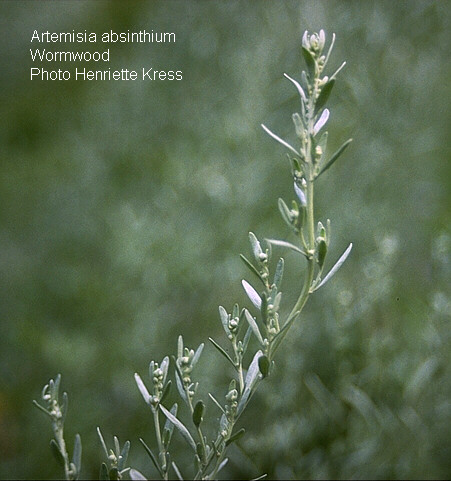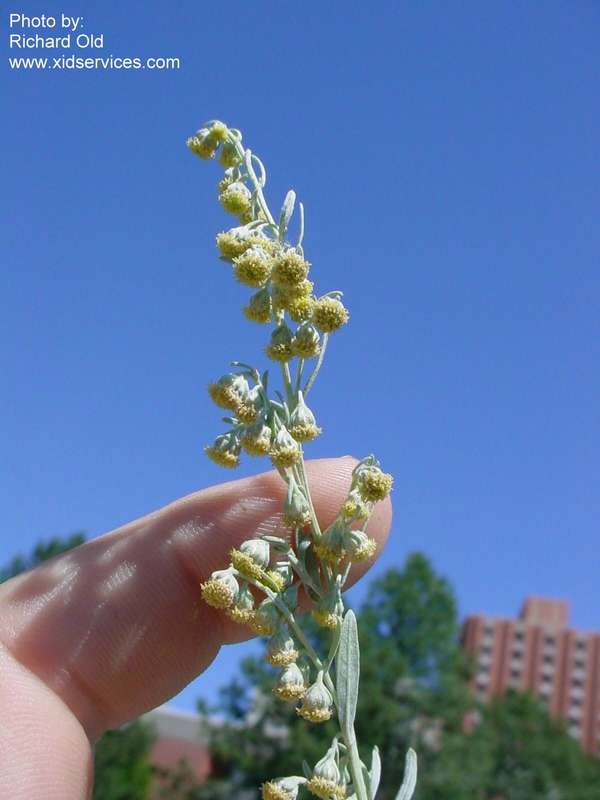Absinth wormwood identification and control
About this weed
Absinth wormwood is a regulated Class C noxious weed in King County. Control is required in King County under the state noxious weed law.
Absinth wormwood is known as Artemisia absinthium, and it is in the aster (daisy) family. Other common names include absinthe, common wormwood, and wormwood sage.

Why it’s a problem
Absinth wormwood causes economic losses in Washington state and elsewhere. All parts of the plant are poisonous if eaten.
It reduces available forage in native and managed rangelands and pastures, tainting the milk of cattle that graze it, and contaminates grain grown as a crop. The pollen is a source of allergy and asthma problems.
Also, absinth wormwood is allelopathic, inhibiting the growth of other desirable plants. Volatile emissions from the leaves prevented wheat germination in one study.
Plant description
Absinth wormwood is an herbaceous perennial (non-woody plants that have a life cycle of 2 or more years) native to parts of Europe and Asia.
Plants generally begin growing between April and early May and start to flower from late July to early August. The above-ground part of the plant generally dies back in the late fall, and the crown of the plant produces buds that give rise to new shoots each spring. Seedlings produce several small leaves close to the soil surface that may go unnoticed in areas with dense grass cover.
Plants can grow 3 to 5 feet tall, and up to 2 feet wide.
Clusters of several upright stems grow from 1 large woody taproot. Lower stems and base of plant are often woody. Upper stems are grooved and often branched. Stems and leaves are usually covered with silky gray hairs, especially when young, but may appear greener and less hairy in moist or shady sites.
Leaves are olive-green above, white below, covered with silky gray hairs, 1 to 5 inches long, divided 1 to 2 times, and deeply lobed. Leaves are spirally arranged on the stem and reduce in size going up the stem. Leaves release a strong sage-like odor when crushed.
Flowers are small, yellowish, disc-shaped, nodding, and arranged in a leafy, spike-like panicle at the top of the stems. Usually, absinth wormwood flowers from July through September.
It reproduces primarily by small, easily scattered seeds. It can also spread somewhat by lateral (sideways) roots. Seeds are dispersed by wind, water, animals, hay, in soil and on equipment. It is a prolific seed producer with up to 50,000 seeds per stem. Seeds are generally viable for 3 to 4 years. The plant re-grows from the ground level each spring. Seedlings emerge from late spring to early fall. Rosettes form by the end of the first growing season.




5


Be aware of look-alike plants
There are several look-alikes to absinth wormwood found in western Washington:
Biennial wormwood (Artemisia biennis)
Coastal wormwood (Artemisia suksdorfii)
Common tansy (Tanacetum vulgare)
Field sagewort (Artemisia campestris)
Mugwort or common wormwood (Artemisia vulgaris)
White sagebrush (Artemisia ludoviciana)
When in doubt, take photos and share them with us or report them on iNaturalist.
What to do if you find it
Property owners are required to control absinth wormwood on lands that they manage. Please notify us if you see absinth wormwood growing in King County.
Our program staff can provide you with site-specific advice on how best to control it. We map all known locations of regulated noxious weeds in order to help locate new infestations in time to control them. For information about other locations, contact your county weed board.
Control methods
We recommend using a combination of methods to control noxious weeds. In areas with few weeds, it is important to act quickly before they become harder to control. Make a long-term plan as it often takes several years to get rid of most weeds. Start in the least infested areas first and then move into more heavily infested areas.
Cultural control
Maintaining healthy pasture soils and competitive grasses can reduce the spread of absinth wormwood. Minimize soil disturbance, avoid overgrazing, and watch roadsides and fence rows for new populations. Disturbed areas should be reseeded with desirable plants to reduce the spread of absinth wormwood.
Manual control
For individual plants or small patches, hand pull or dig up the roots when the soil is moist, making sure to remove all the roots.
Mechanical control
In crop production areas, tillage can prevent establishment.
Summer fallow followed by fall tillage is more effective than spring tillage.
Mowing can prevent seed production if done several times throughout the growing season. This is not generally effective at reducing the size or density of the infestation unless other methods are used in combination with mowing. Mowing after plants have begun to produce seeds will spread seeds to other locations outside the site.
Chemical control
Stay safe when using herbicide:
- Always read the label before use.
- Wear a long-sleeved shirt, long pants, shoes, and eye protection.
- Follow state and local regulations.
Herbicides with the following active ingredients are some of the options available for effective control of absinth wormwood:
- Aminopyralid
- Clopyralid
- Dicamba
- Glyphosate
- 2,4-D
For best results, spray the foliage and stems of actively growing plants when they are at least 12 inches tall. Better control can be achieved if treated in late June to August compared to spring or fall treatments.
For fall treatments, mow in early to mid-summer first to promote active regrowth in the fall. Use of a spreader-sticker (surfactant) is essential due to the fine hairs covering the plant.
For more information, contact us or your local weed board.
Disposal instructions
In order to prevent spreading seeds, plants with flowers or seeds should not be placed in compost bins or yard waste piles. Instead, place in a bag and dispose of in the garbage. Absinth wormwood without flowers can be left on site or disposed of with other yard waste, as long as livestock do not have access to it.
Noxious Weed Disposal - Washington State Noxious Weed Control Board

 Translate
Translate